You are currently browsing the tag archive for the ‘Cook County Jail’ tag.

Photographer/reporter Lili Holzer-Glier’s Inside the Massive Jail That Doubles as Chicago’s Largest Mental Health Facility marries meaningful and well-reported content and with hard-hitting images under a single byline.
It’s a day-in-the-life-ish of the mental health professionals and patients at Cook County Jail in Chicago, which is the largest walled institution in the United States. What stood out for me was the reason with which both patients and professionals speak and assess the situation. Even though their attitudes could be dismissed as those from a madhouse in the big house, these first-hand-responders are collected and clear in what the problems are and what the solutions might be. And, surprise! Incarceration is not a solution.
I was left to reflect on my own frantic dismay at the United States’ beyond broken mental health policies. But panic doesn’t help anyone. Reliable and committed health helps and this is the overriding takeaway from Holzer-Glier’s piece. The pictures reflect that too. There’s no outbreaks, no violence and no real “noise”. The patients are returning to a baseline and feeling listened to. It’s just a shame they have to be in a jail to receive that attention.
Holzer-Glier opens the piece with a volley of desperate facts.
“According to a May 2015 report by the National Alliance on Mental Illness,” writes Holzer-Glier, “Illinois cut $113.7 million in funding for mental health services between 2009 and 2012. Two state-operated inpatient facilities and six City of Chicago mental health clinics have shut down since 2009. The report goes on to detail that Governor Bruce Rauner’s 2016 budget proposal to slash $87 million of funding for mental health services could cause an estimated 16,533 adults to lose access to care.”
From the way the article reads, it seems Holzer-Glier spent one day (November 10th 2015) observing the in-take and processing. She follows social worker Elli Petacque-Montgomery and her team as they assess new arrivals at the jail.
“Acutely psychotic, violent, or suicidal arrestees [are put] in single cells away from other inmates. People who are psychotic are then sent to CERMAK, the jail’s division for physically ill and acutely mentally ill patients. Those with minor mental illness are sent to Division Two, Dorm Two, where they live in dormitory-style bunk beds…”
While the four prisoner-patients Holzer-Glier meets–Milton, Daniel, Tommy, and Andrew–have problems they aren’t totally bereft of hope. They’re in the bunks of Dorm Two. They provide key insight. Thankfully, Holzer-Glier doesn’t make a case for them, but rather allows them to make their own case. Their statements are transcribed.
They speak with gratitude about how the attention they receive from the medical staff is professional, encouraging and helpful. They have hope they can find stability but they don’t (or can’t) offer too many certain routes to stability. Some plan to leave Illinois when they get out. Some hope to find a good balance from meds that have proved helpful in the past. Another just plans on a steak and a hot bath “to get rid of the crazies.”
In each case, it’s clear they’ll need assistance beyond these jail walls. But will they have access to care? Ask the professionals. Holzer-Glier closes the piece with a series of statements from a clinical psychologist, a social worker, a guard, director of the care center and a corrections rehabilitation worker, all of whom work in Cook County Jail and interface with the mentally ill prisoner-patients. They all report that mental health institutions elsewhere have been closed at a incomprehensible rate and that the majority of people they interface with in the jail should be in a medical facility not a prison.
“You can’t just take a mentally ill person and lock them away. Society has already shown it doesn’t work,” says Printiss Jones, the Superintendent of CERMAK, the jail’s division for physically ill and acutely mentally ill. “Why would we do it here?”
And the piece ends.
Jones says, “Not one of these people should be here.”
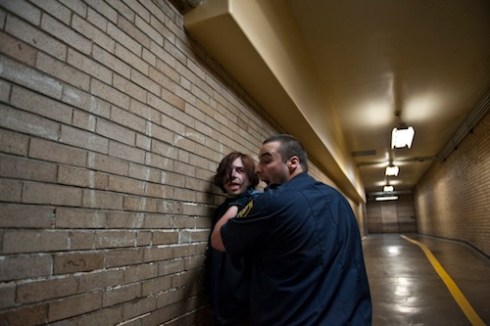
A Corrections Officer forcibly restrains an unruly prisoner who was screaming and claiming abuse by the officer, Cook County Jail, Chicago, Illinois. April, 2011.
CONTEXT
In April 2011, Peter van Agtmael was assigned by Newsweek to photograph Tom Dart, the Sheriff of Cook County, Chicago, Illinois. The coverage involved one day’s access to Cook County Jail and day of access to the ride-alongs with the PD. With a daily average of 11,000 inmates, Cook County Jail is the largest facility of detention in the U.S.
During his time in the jail, van Agtmael witnessed an altercation and heard allegations of abuse.
“The possibility of one more day of access to the jail was floated, but then didn’t come through.”
It is uncertain as to whether van Agtmael’s photographs of the contact between prisoner and deputy affected the decision to cancel the next day’s proposed visit. Van Agtmael isn’t even sure if it was Newsweek or the Sheriff’s department’s decision to cancel.
Newsweek consequently killed the story.
“I don’t know why the story was killed,” says van Agtmael. “No reason was given. Tony Dokoupil, the reporter, briefly referenced the trip in a May 29, 2011 article, Mad As Hell.”
Van Agtmael explains the background to the story, “Dart had became notorious in 2008 for halting evictions tied to foreclosure. He became something of a populist hero, and a deal made with the courts gave homeowners and tenants more leeway to contest their evictions.”
TESTIMONY
Van Agtmael recounts, “Sheriff Dart was giving Tony Dokoupil and I a tour of the jail system, and I heard screams and dull thuds coming from down a corridor. I ran towards the sounds and began photographing a cop pushing the young man against a wall. I began photographing the scene. The young man was screaming that the officer had been beating him, and the officer was yelling at me to stop photographing as he pushed the man further down the hallway. I followed and continued to photograph.”
[Continues below …]
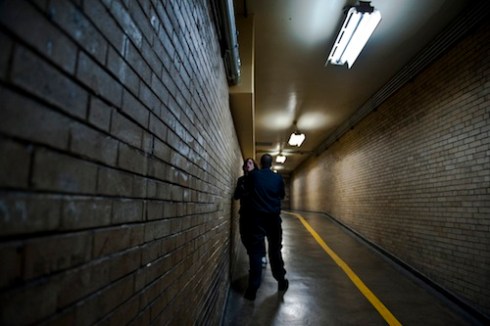
A Corrections Officer forcibly restrains an unruly prisoner who was screaming and claiming abuse by the officer.
“The officer kept yelling at me to stop, and seemed to be trying to simultaneously restrain me as well as the man, but I kept out of arm’s length and explained that I was a guest of Sheriff Dart and had been promised open access to the jail. A moment later, Dart appeared and upon his arrival the situation calmed considerably. He asked the man to explain what had happened to him, wrote a few things down, and then the police officer pushed the young man into an elevator.
[Continues below …]

“A few minutes later we came across the bald man who asked me to take his picture and whispered to me that the cops had punched him repeatedly in the face, resulting in the bruising in the portrait. I had no way of independently verifying the statement,” says van Agtmael.
[Continues below …]

A Corrections Officer leads a prisoner – who had tried to escape – to a holding cell. The man was cut and bruised and claimed he had been beaten by officers after he tried to escape.
“Honestly, it’s very hard for me to make an informed commentary based on a day spent in the jail system. I saw a lot of desperation, and heard stories of alleged abuse, but the context and time limitations would compromise any superficial interpretation. I’ll let the pictures represent my experiences,” van Agtmael concludes.
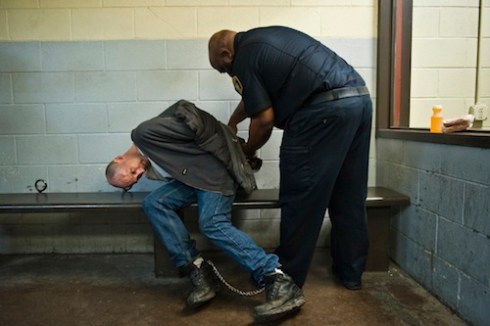
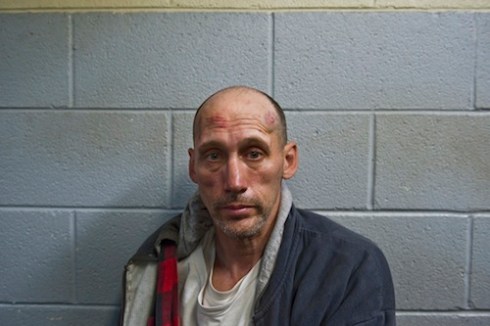
Inmate of Cook County Jail who is cut and bruised. He claimed he had been beaten by officers after he tried to escape.
THOUGHTS
This ambiguous series of photographs goes right to the heart of the efforts I make on Prison Photography to decipher prisons and jails, which for the most part are invisible worlds. Immediately, their meaning and interpretations are up for discussion; they are contested.
Maybe, Newsweek wanted a fuller picture of the Cook County Jail system? Maybe, the relevance of the planned story passed? For me, the fact the story was killed is a sad turn of events.
Getting involved in meta-analysis of journalism can be dangerous but in van Agtmael’s photographs are the kernels of a larger story. It’s not that the stories of these two inmates and these two correctional officers were not told, it is that no story at all was told.
But, let’s not be churlish; this blog post is not an exposé. Van Agtmael’s images are not an illumination of a definable event because the details cannot be verified. They are, however, a depressing suggestion of the fraught and intense-contact situations that play out in prisons and jails across the U.S. every day.
I am not amplifying the inmates’ allegations; to do so would be baseless. I also don’t want to appear to be generally criticising correctional officers. I will however criticise politicians and a voting public that allows mammoth-sized prisons and jails to operate. The experience of prisoners and staff would be less frantic in smaller institutions, and in institutions designed to treat (as well as categorise) and not necessarily detain as their main task.
By publishing these photos my aim is to – again – call readers to think not only about the images they see but those they don’t see. Ultimately, I take van Agtmael’s tack, which is, to let the photographs speak for themselves.
– – – –
Here’s some other selects from van Agtmael’s visit to Cook County Jail:
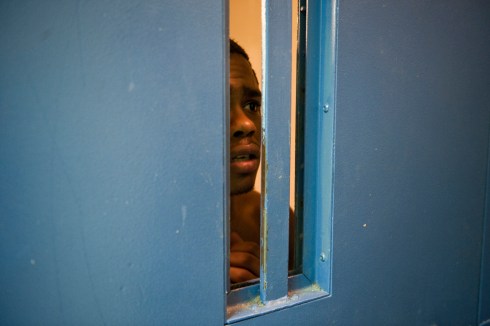
Anthony Smith, a prisoner in the Cook County Jail, Chicago, IL, complains to Sheriff Tom Dart about his treatment and sentence.

Sandwiches for prisoners in the Cook County jail system.

An employee of the Cook County jail system.

A deputy at the Cook County Jail.
PETER VAN AGTMAEL
Peter van Agtmael (b. 1981) graduated from Yale University in 2003 with a degree in History. Following graduation, he spent a year in China on the Charles P. Howland fellowship photographing the effects of the Three Gorges Dam. Since the beginning of 2006, he has documented the consequences of America’s Wars, at home and abroad. A monograph of the work, ‘2nd Tour Hope I Don’t Die’ was published in 2009. In 2008, he helped organize the exhibition and book Battlespace, a retrospective of unseen work from 22 photographers covering Iraq and Afghanistan. Peter is represented by Magnum Photos.
Peter van Agtmael has been awarded the ICP Infinity Award for Young Photographer (2011); PDN Photo Annual (2011); PDN 30 (2010); PDN Photo Annual (2010); American Photography Annual (2010); FOAM Talent (2009); Santa Fe Project Competition – Honorable Mention; Pulitzer Center Grant (2008); World Press Photo Joop Masterclass (2008).
– – – –
All images: Peter van Agtmael/Magnum Photos.

This afternoon, I’ll be speaking to photography students at Evergreen State College, Olympia, WA. Instructor, Steve Davis has asked me to discuss PPOTR, regale some stories, recount my interviews.
Without doubt, Lloyd Degrane‘s story was one of the most remarkable. I have yet to edit the audio of Lloyd’s interview, but I did transcribe part of our conversation so it could be included in the Cruel & Unusual/PPOTR Newspaper. I’d like to share the text (below).
When Lloyd and I met in Chicago, he was preparing for Prison, the first ever exhibition of his prison photographs. It was at Gage Gallery (which coincidentally just showed Lori Waselchuk – another PPOTR interviewee). Gage put together an audio slideshow, which I also wanted to share (bottom).
THE BACKSTORY
Lloyd is a gentle, unassuming, older gent. He worked diligently for an entire decade (1990-2000) within three Illinois prisons – the Joliet Receiving Center, the Stateville Maximum Security Prison and Cook County Jail (the largest walled facility in the world with approximately 11,000 inmates). Degrane did this without any fuss or anything approximating self-promotion.
Before the authorities allowed him in with his camera, the Department of Corrections sent Degrane on a 600-mile round-trip to Menard Prison, a maximum-security prison in Southern Illinois. At Menard, Degrane was to just have a tour of the facilities. The warden instructed him not to take in his camera, and said that they he discuss with Degrane the proposed photography project after Degrane has taken the tour.
Due to an extraordinary experience during his prison visit, Degrane never met the warden. The extraordinary experience did, however, give Degrane a bargaining chip with which to win access to the Illinois prison system.
LLOYD’S FIRST DAY IN PRISON
I was led around Menard Prison by a guard that was just about to retire. You don’t get comfortable for some time. On the yard, you’re walking around brushing shoulders with murderers and rapists. I’d never been around people who had committed heinous crimes.
We walked into a big cell house holding several hundred inmates. As we got to the centre of the cell house a race riot broke out around us. I later found out is was African American inmates who wanted to retaliate against a white biker gang for killing one of their own several weeks before, and we were right in the middle of that retaliation. I remember yelling and threats being directed at the guard I was with. I was wearing a white shirt at the time and prisoners stopped and looked at me as if to ask, “What is this guy doing here?” I ran with the guard through a gauntlet of muscular black inmates. We made it to a cell and inside the cell was one of the oldest inmates I’d ever seen – over seventy years of age. And the guard just pushed me inside the cell. And the race riot went into high gear then. The first thing I saw was a white biker gang member being beaten by four or five black prisoners and the beating got closer and closer to the cell I was in. One of the black prisoners picked up the white biker and threw him against the bars. His head split open and he fell right at my feet. That was my initiation into maximum-security prison. I thought he was dead.
I heard over the loudspeaker system “CIVILIAN INSIDE” and I looked at the guard who was in the cell with me and he pointed at me and he said, “That’s you”. About five minutes later I heard the state police come into the cellblock with kind of this chant from the wizard of Oz. It was a chant to get everyone psyched up and strike fear into the heart of the rioting prisoners. They marched in with clubs and they were there to rescue me. They made a pathway through this insanity and extracted me from the cellblock along with the officer. They got me out of the cellblock back to the warden’s office where I picked up my camera and they just kind of pushed me out the back door.
I went to the nearest tavern and had a couple of shots of whisky. The adrenaline was just incredible, to the point where I couldn’t sit down. I’d nearly lost my life and I’d never had an experience like that before.
Later that day, I contacted the communications officer for the Illinois Department of Corrections. He knew what had happened. He said, “If you don’t talk to the media about what happened today then we’ll send you into Stateville Prison,” And so I didn’t say anything. Two weeks later I got notice from the warden at Stateville that it was okay to come in and start the project.
Lloyd DeGrane‘s work is long-term and it is honest. DeGrane would like to see more transparency surrounding American correctional facilities, “I think people, taxpayers should see what they’re getting for their money”. I came across DeGrane in James R Hugunin’s 1996 curated exhibit Discipline and Photograph.
DeGrane carried out his Prison series between 1990 and 2001, when he photographed within the state maximum security Stateville Correctional Center, Illinois and Cook County Jail in Chicago. The three photos featured here each depict scenes at Stateville.
DeGrane took the time to discuss the role of photography in sites of incarceration, a photographer’s best approach, the names and labels given to him by inmates and images of the spaces between cells.
Did you await each photo opportunity? While working, were you alone or accompanied on the corridor or wing?
“I was usually escorted by a counselor – an unassuming, non-threatening person. Sometimes I’d go into a unit and walk around by myself, being careful not to get out of the view of a correctional officer. Stateville is a maximum security facility so some of the inmates were violent offenders. I talked to the inmates directly, sometimes going into their cells. For the most part the officials let me browse freely and talk to any inmates I wanted. Things, to a point, were pretty transparent. When I came into a unit someone would usually yell out my arrival”.

Isolation Unit, Stateville Correctional Center, 1992. Lloyd Degrane
What is happening in the Isolation Unit photograph?
“This is the isolation unit – I called it ‘the jail within the prison’. Inmates who committed an offense in the prison were taken out of the general population and held there 23 hours a day with one hour for outside exercise. That [the display of legs and arms] was the first reaction to me being on the wing”.
“The inmates, for reasons unknown to me, thought I was a state official of some kind. But, after I got to talking with a few people independently I was able to photograph several inmates with no problems, with the exception of one inmate who would try to throw excrement at the guards”.

Lockdown Protest, Stateville Correctional Center, 1993. Lloyd Degrane
Explain the situation here, with the trash and food on the floor.
“That was taken in 1993. Inmates were ending a five day lock-down and totally disgusted by the lunch served (cold baloney sandwiches every day). So, they threw the servings out of their cells onto the floor. The floor of the wing is commonly known as ‘the flag’.”
“Guards eventually had to clean it up. I noticed when I came back the next week that the roach problem was severe. I had to tuck my pant legs into my socks so the roaches wouldn’t crawl up my legs”.

Protective Custody Unit, Stateville Correctional Center, 1992. Lloyd Degrane
The interaction between the guard and inmate in the protective custody unit is fascinating – it melds contortion, humanity, routine and unlikely types for the prison environment.
“The inmate was in the protective custody unit. That’s a pregnant guard that’s looking at him. He didn’t have a mirror so the only way he could see what was happening outside his cell was to stick his head out of the food tray slot.”
Did the subjects of your images, specifically inmates, see the photographs after they were produced/exhibited?
“I always made a small photo for the inmates. Sometimes they got them and sometimes the warden or captain (for reasons I do not know) didn’t get around to giving them the photo. But, I was able to get a little deeper into the lives of the inmates that received photos.”
How do you work?
“The images are made slowly and carefully. No surprises. Observation and discussion with the inmates and then photos. That was my modus operandi. It’s like going into someone’s home, they know you’re there! So, it’s best to be respectfully curious. Some inmates wanted nothing to do with me (I think they had committed other crimes on the outside and didn’t want to be recognized). Other inmates didn’t mind at all. I talked with people all the time. I think taxpayers should see what they’re getting for their money. Transparency is key. But, many prison officials believe the opposite and in their facility, they rule!
Final thoughts on the prison system?
Prisons – and not correctional facilities (as the State of Illinois has named their institutions) – the concrete human warehouses behind razor wire are just that! Buildings that confine people. It’s an existential experience in a world that is both separate from America but a big part of the American economy. One sees homemade signs along Interstate 55 that read, ‘Don’t shut our prison down’, ‘Save the prison, Save our jobs’ outside Pontiac, Illinois, home to another maximum security facility that may close because of state budget cuts.
Don’t get me wrong though, some people belong in prison. I met many men who raped innocent women, killed children, beat other men to death for a few dollars and some who murdered their cellmates. I was glad that I didn’t meet them in a dark alley in Chicago. But, one thought that always went through my mind was, most of these people will get out some day. Will they change for the better or just be better criminals?
You kept an index of how the prisoners referred to you. It’s length, variety and contradictions reflect well the complexity of social experience within correctional facilities. Can you remind us of the index?
This is my index of how inmates referred to me. Picture Man, White man, The Man White Mother Fuckin’ Press Man, Black Gang Lover, Spic Gang Lover, White Prisoner Lover, Straight Dude Looking for Something – Policeman, The Photo Man, The European, The Springfield Connection, A Fair Man, An O.K. Photographer, An Artist, Homes, Homey, Fuckin’ Photographer, Homo, Fuckin’ Camera Man, The Camera Man, Inmate Lover, The Police, Friend and Cute Mother Fucker (The label given to me by Richard Speck).
